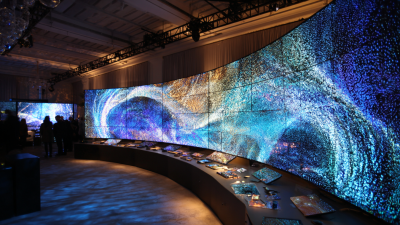Exploring the Evolution of Display Panels and Their Impact on Modern Technology Trends
Table of Contents
- The Rise of OLED Technology and Its Influence on Consumer Electronics
- Comparative Analysis of LCD vs. AMOLED: Which Reigns Supreme?
- Energy Efficiency in Display Technologies: A Statistical Overview
- The Role of Display Panels in Advancing Mobile Device Functionality
- Future Trends: Mini LED and Micro LED Innovations in Displays
- Impact of Display Quality on User Experience in Gaming and Streaming
- FAQS
- Conclusion
- Related Posts
The evolution of display panels has significantly shaped modern technology trends, particularly within educational and commercial sectors. As an integral component of various devices, display panels, including LCD and LED technologies, have seen remarkable advancements, with the global display market projected to reach a valuation of over USD 200 billion by 2025, according to industry reports. Ledersun Technology Co., Ltd. stands at the forefront of this innovation, specializing in LCD display technology applications. The company's commitment to providing high-quality interactive whiteboards for educational environments and dynamic digital signage for commercial use highlights the transformative impact of display panels. As businesses and educational institutions increasingly seek effective communication tools, the demand for advanced display solutions continues to grow, marking a pivotal shift in how information is consumed and experienced across diverse platforms.

The Rise of OLED Technology and Its Influence on Consumer Electronics
The rise of OLED technology is reshaping consumer electronics, driving advancements in display quality and energy efficiency. As the global market for display panels is set to reach a staggering $156.47 billion by 2024, OLED's integration into mainstream laptops reflects a significant shift in design and functionality. With solid-state structure, OLED displays offer brighter colors and deeper contrasts, enhancing user experiences, particularly in gaming and multimedia applications. The trend of "mainstreaming and gaming" signals a dual approach, catering to diverse consumer preferences across high-performance devices.
Tips: When selecting a display for your next device, consider how OLED can enhance your viewing experience, especially if you're into graphic-intensive tasks or gaming. Investing in OLED technology can also save energy in the long run due to its efficient power consumption.
Furthermore, the competitive landscape is evolving, as manufacturers are rapidly adopting flexible OLED technologies, fostering innovation and pushing the boundaries of traditional display formats. The Asian market is expected to dominate, capturing nearly 39.9% of the share in 2024, which highlights a regional push towards adopting advanced display solutions. Embracing these technological advancements not only benefits manufacturers but also consumers, who can enjoy cutting-edge displays in their electronic devices.
Tips: Stay informed about the latest developments in display technology, as advancements like OLED can significantly impact your purchasing decisions. Consider future-proofing your devices with the latest display innovations.
Impact of Display Panel Technologies on Consumer Electronics
Comparative Analysis of LCD vs. AMOLED: Which Reigns Supreme?
As the smartphone industry continues to evolve, display technology plays a crucial role in shaping user experiences. Currently, two predominant display technologies are LCD and AMOLED.
According to industry reports, AMOLED panels offer superior contrast ratios and deeper blacks due to their ability to turn off individual pixels completely, resulting in enhanced visual performance, particularly in dynamic content. Research indicates that AMOLED displays often result in more vibrant color reproduction, with a wider color gamut than standard LCD panels, which tend to have more limited color accuracy.
On the other hand, LCD technology has made significant strides, particularly with advancements like Mini-LED and Quantum Dot enhancements that improve brightness and color quality. Reports suggest that LCDs remain more energy-efficient during bright scenes compared to AMOLED, as they do not experience the same power drain when displaying lighter hues. However, AMOLED displays show better performance in dark mode applications, further entrenching their position in high-end devices. Each display type has its distinct advantages, influencing consumer choice in flagship devices well into the competitive landscape of 2025, where performance vs. efficiency debates continue to dominate.
Energy Efficiency in Display Technologies: A Statistical Overview
The evolution of display panel technologies has brought significant advancements in energy efficiency, reflecting a critical response to modern technological demands and environmental concerns. Various display types, from LCDs to OLEDs, demonstrate quantifiable improvements in power consumption. For instance, OLED panels, which utilize organic compounds to emit light, have been shown to consume up to 30% less energy than traditional LCDs, especially when displaying darker images. This enhancement not only benefits device performance but also extends battery life for portable electronics, making them more user-friendly.
Recent statistics reveal a growing trend towards energy-efficient displays across various sectors, particularly in consumer electronics and commercial applications. According to industry analyses, the shift to more sustainable display solutions has resulted in a reduction of energy usage by about 20% in household devices over the past five years. Coupled with government regulations and consumer preferences increasingly favoring eco-friendly technologies, manufacturers are incentivized to innovate further. This ongoing transition underscores the integral role energy efficiency plays in shaping the future of display technologies, driving both market competitiveness and environmental sustainability.
The Role of Display Panels in Advancing Mobile Device Functionality
The rapid advancement of display panel technology has profoundly impacted the functionality of mobile devices. Modern smartphones and tablets are equipped with high-resolution screens that offer vibrant colors and sharp images, enhancing user experience across various applications. This evolution is not just about aesthetics; advanced display technologies, such as OLED and AMOLED, have led to improvements in energy efficiency, allowing devices to run longer on a single charge.
Tips: When selecting a mobile device, pay close attention to the display specifications. Look for features like brightness levels and refresh rates, as these can significantly affect usability, especially in outdoor environments or during gaming. Additionally, consider devices with adaptive display technologies that adjust screen settings based on ambient lighting, ensuring optimal viewing conditions.
Furthermore, the integration of touch technology with display panels has transformed interaction with mobile devices. Multi-touch capabilities enable users to perform complex gestures, enhancing productivity and making daily tasks more efficient. As new display technologies emerge, such as flexible and foldable screens, the potential for innovative mobile device designs will continue to grow, offering users unprecedented versatility.
Tips: Always seek out devices that incorporate the latest display innovations, as they often come with enhanced features that improve not only the visual experience but also the overall functionality. Consider testing devices in-store to get a sense of responsiveness and comfort before making a decision.

Future Trends: Mini LED and Micro LED Innovations in Displays
The CES 2025 event has unveiled groundbreaking innovations in Micro and Mini LED displays, emphasizing their versatility across various sectors. From high-definition televisions to augmented reality glasses and automotive displays, these advancements are setting new standards in visual technology. The integration of Micro LED technology not only enhances image quality and energy efficiency but also allows for thinner and lighter designs, which is crucial for the increasing demand for portable devices.
As highlighted during the SID 2025 event, the Micro LED display market is anticipated to experience substantial growth, projected to reach over $54 billion by 2033, with an impressive CAGR of 58.27%. This surge is driven by advancements in technology and the growing adoption of Micro LEDs in diverse applications, including wearables and large video displays. Companies are exploring innovative ways to power these displays, such as embedding them into energy-efficient solar panels, which showcases the potential for sustainability in future devices. The excitement surrounding these technologies underscores a significant shift towards highly interactive and immersive experiences in everyday consumer electronics.
Exploring the Evolution of Display Panels and Their Impact on Modern Technology Trends
| Technology Type | Resolution (Pixels) | Brightness (nits) | Power Consumption (Watts) | Lifespan (Hours) | Market Adoption Year |
|---|---|---|---|---|---|
| LCD | 1920 x 1080 | 250 | 60 | 50000 | 2005 |
| OLED | 3840 x 2160 | 1000 | 90 | 25000 | 2012 |
| Mini LED | 7680 x 4320 | 2000 | 85 | 50000 | 2020 |
| Micro LED | 7680 x 4320 | 3000 | 70 | 100000 | 2022 |
Impact of Display Quality on User Experience in Gaming and Streaming
The evolution of display panels has significantly altered user experience in gaming and streaming, with quality becoming a key differentiator in the market. According to a report by Statista, the global gaming monitor market is projected to reach $5.9 billion by 2027, fueled by advances in display technology like increased resolution and refresh rates. These improvements not only enhance visual fidelity but also create a more immersive gaming environment, allowing players to engage at a deeper level. High-definition displays that support 144Hz refresh rates or higher provide smoother motion rendering, which is crucial in competitive gaming, where milliseconds can determine victory.

Similarly, streaming services are adapting to the demand for higher display quality. A study from the Consumer Technology Association revealed that 75% of consumers prioritize high video quality when choosing a streaming service. As platforms adopt 4K and even 8K content, the need for displays that can handle such resolutions becomes imperative. OLED and QLED technologies, known for their superior contrast ratios and color accuracy, are at the forefront of this shift. The integration of these advanced panels not only enhances the viewing experience but also influences content creation, driving higher production standards in the industry.
FAQS
: OLED technology is a display technology that offers brighter colors and deeper contrasts, significantly enhancing display quality and energy efficiency in consumer electronics. Its integration allows for improved user experiences, especially in gaming and multimedia.
OLED displays are known for their superior color accuracy and deep contrast ratios, making them ideal for graphic-intensive tasks like gaming and multimedia applications. They provide a more vibrant and immersive viewing experience.
OLED displays generally offer better contrast and color reproduction than LCDs, as they can turn off individual pixels completely. However, advancements in LCD technology, such as Mini-LED and Quantum Dot enhancements, have improved their performance as well.
AMOLED panels provide superior contrast ratios, deeper blacks, and more vibrant colors. They perform better in dark mode applications, making them ideal for high-end smartphones and dynamic content.
Higher display quality, particularly with increased resolution and refresh rates, significantly enhances the gaming experience by providing smoother motion and more immersive visuals, which are critical in competitive gaming.
Display quality is vital for streaming services, as 75% of consumers prioritize high video quality when selecting a service. Technologies like OLED and QLED are essential for delivering high-definition and 4K or 8K content.
The global gaming monitor market is expected to reach $5.9 billion by 2027, driven by advancements in display technology that enhance visual fidelity and user experiences.
Consumers should consider how OLED technology can enhance their viewing experience, especially for tasks that are graphic-intensive. Additionally, energy efficiency and future-proofing with the latest display innovations are important factors.
Conclusion
The article titled "Exploring the Evolution of Display Panels and Their Impact on Modern Technology Trends" delves into the significant advancements in display panel technologies, particularly emphasizing the rise of OLED and its influential role in consumer electronics. A comparative analysis between LCD and AMOLED technologies highlights the strengths and weaknesses of each, while an overview of energy efficiency in display technologies presents critical statistical insights that underscore their environmental impact.
Furthermore, the article discusses how display panels have played a crucial role in enhancing mobile device functionality and explores future trends such as Mini LED and Micro LED innovations. The examination of display quality reveals its critical impact on user experiences in gaming and streaming, illustrating the ongoing evolution of display panels and their integral importance in shaping modern technology trends. As Ledersun Technology Co., Ltd. focuses on LCD display applications, the insights drawn from this article can enhance our understanding and developments in interactive whiteboards and digital signage.
Related Posts
-

The Future of Display View Technology Revolutionizing Visual Experiences
-

The Future of Learning with Interactive Flat Panels in Modern Classrooms
-

How to Choose the Right 55 Inch Touch Screen Kiosk for Your Business Needs
-

Ultimate Guide to Choosing the Perfect 55 Touch Screen Kiosk for Your Business Needs
-

Embracing Future Trends in Digital Signage for 2025 and How to Prepare Your Business
-

Advantages of Using Digital Display Boards for Modern Office Environments
Blog Tags:





